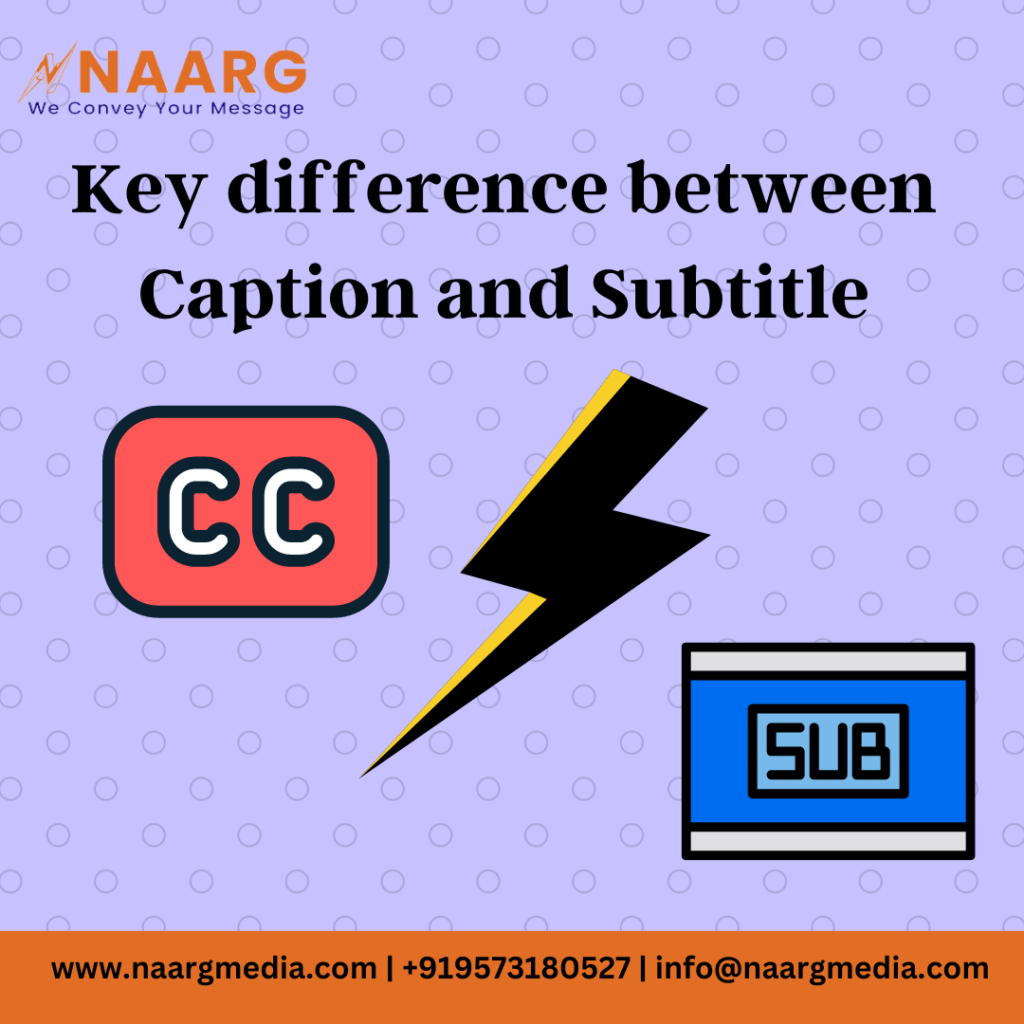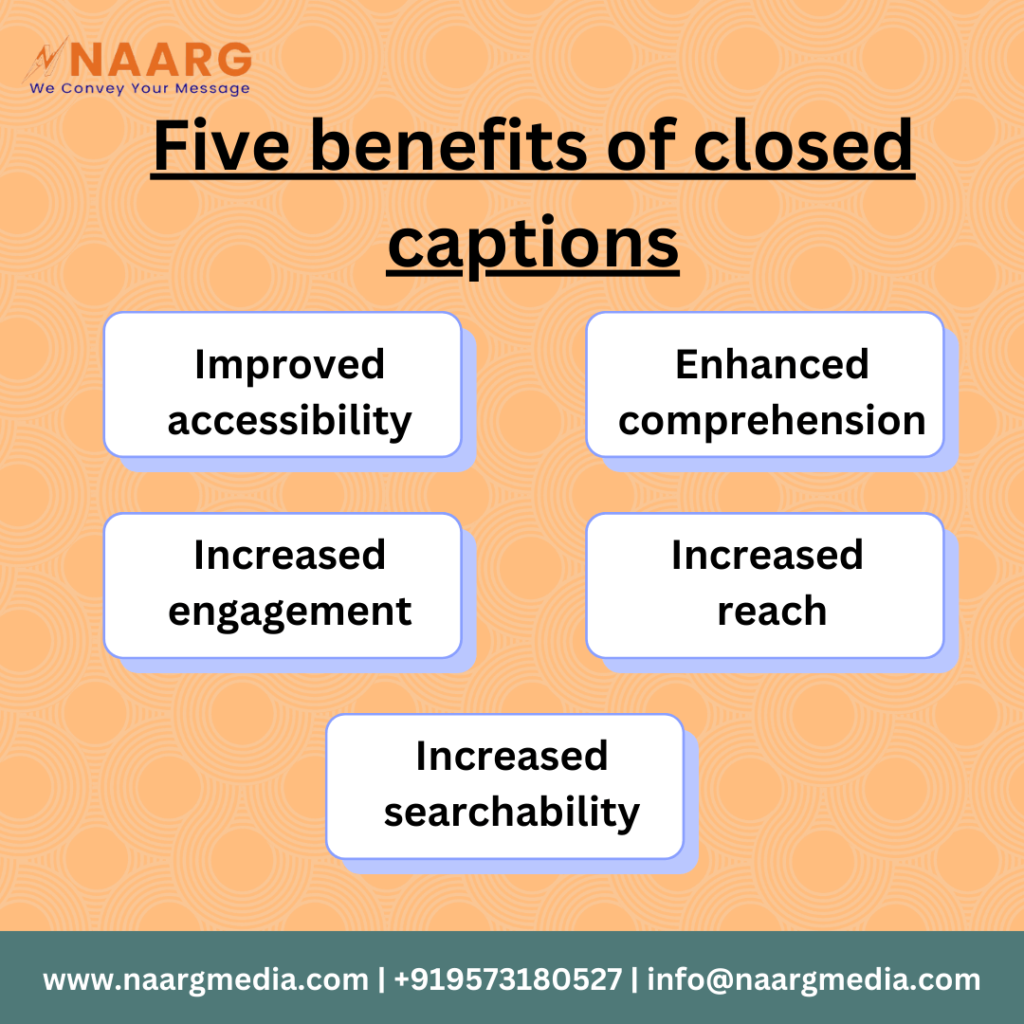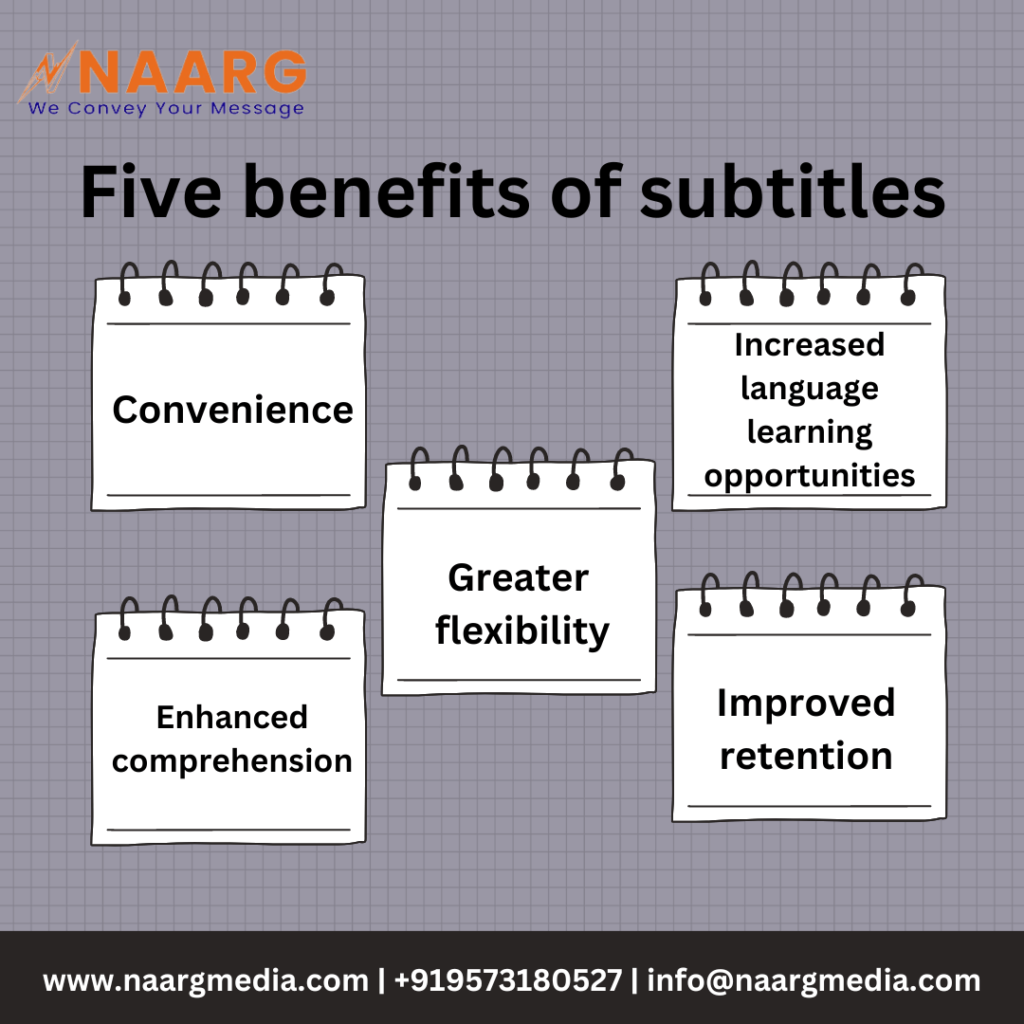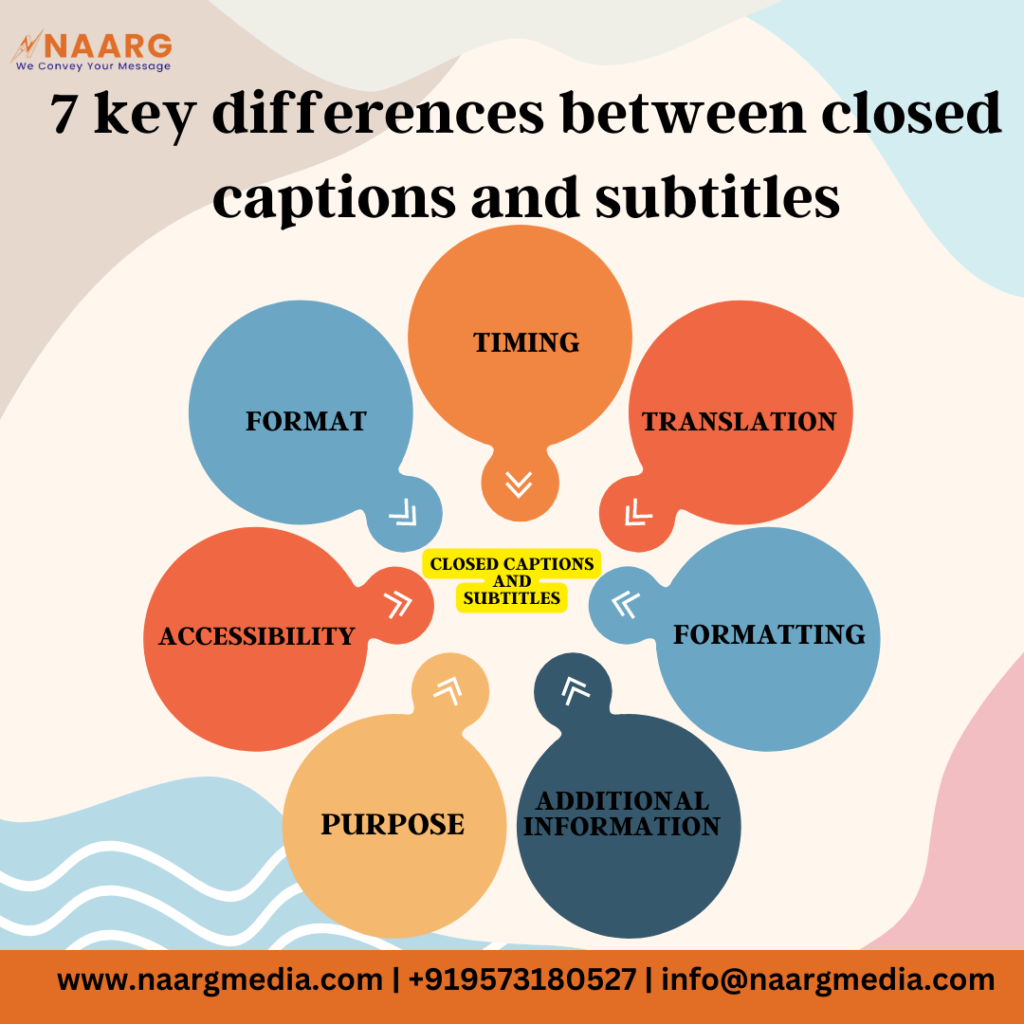Closed captions and subtitles are text versions of spoken dialogue and other audio information in videos. They are typically used to provide accessibility for viewers who are deaf or hearing impaired. They can also be used for other purposes, such as providing translations for non-native speakers or displaying text on-screen for emphasis. Closed captions and subtitles are similar in providing written text on a screen to help viewers understand spoken dialogue or sound effects.
So, what is the difference between closed captions and subtitles? However, there are some critical differences between the closed captioning and subtitles. Closed captions are often embedded in the video file itself and can be turned on or off by the viewer. At the same time, subtitles files are typically separate files displayed as overlaid text on the video. Both closed captions and subtitles can be created and edited using specialised software.

What does stats say?
According to a survey conducted by the National Center for Accessible Media in 2011, approximately 71% of viewers use closed captions on television. Another study conducted by Captioning Key in 2013 found that 98% of respondents agreed that closed captions are essential for individuals who are deaf or hard of hearing.
A survey of over 1,000 online video viewers conducted by the video platform provider Kaltura in 2016 found that 79% of respondents use captions or subtitles when watching online videos, with the majority (56%) saying they use them to understand dialogue in videos better.
Additionally, a study by the streaming giant Netflix from 2020 stated that 85% of its global viewers use subtitles or closed captions on its platform.
Why should we use closed captions?
Closed captioning refers to the text on the screen to provide audio descriptions for deaf and hard of hearing or non-native speakers. There are several reasons why closed captions should be used. Firstly, closed captioning provides equal access to audio information for individuals who are deaf or hard of hearing. It enables them to understand the audio content of a video without relying on lip-reading or sound.
Secondly, closed captioning can help improve language skills for non-native speakers. By having the text displayed on the screen, they can learn new words, grammar and sentence structures. Third, closed captioning can be helpful in noisy environments where the audio is poor or when the audio is muted. In these situations, closed captioning provides a valuable source of information.
Lastly, closed captioning also helps in search engine optimization, making it easier for people to find the video when they search for keywords mentioned in the text. Closed captioning has numerous benefits and should be considered in any audio-visual production.
Naarg Media provides the highest quality closed captioning service for videos. Having multilingual captionalist that create accurate captions in different languages is something we take pride in. Naarg Media have provide closed caption services in many big companies like Netflix, Amazon, Disney, Bharti and many more.
Five benefits of closed captions:

Improved accessibility:
Closed captions provide an alternative way for people with hearing impairments to access and understand audio content.
Enhanced comprehension:
Closed captions can help viewers better understand the video content or audio content recording, especially if the speaker has an accent or uses technical jargon.
Increased engagement:
Closed captions can make videos content and audio recordings more engaging for viewers, as they can follow along with the spoken content and understand the context of the visuals.
Increased reach:
Closed captions can make videos and audio recordings accessible to a broader audience, as people who speak different languages or foreign languages have hearing impairments can still access the content.
Increased searchability:
Closed captions can improve the searchability of videos and audio recordings, making it easier for viewers to find specific information or content within the recording.
Why should we use subtitles?
Subtitles are an essential aspect of modern entertainment and have many benefits. Firstly, they provide accessibility to individuals who are hearing impaired or have difficulty understanding spoken language. This allows them to enjoy movies, TV shows, and other forms of entertainment without being excluded. Secondly, subtitles help language learning and improve language proficiency by exposing the viewer to a new language. They help to enhance the listening skills of individuals and build vocabulary.
Additionally, subtitles are also helpful for individuals who are watching a movie or TV show in a language they are unfamiliar with. They can help the viewer to understand the story better and follow the dialogue. Lastly, subtitles also provide entertainment for individuals who are hard of hearing or deaf. They can enjoy movies and TV shows just as anyone else would, with the added benefit of having a written version of the dialogue to follow. In conclusion, subtitles are a valuable tool for enhancing accessibility, language learning, and entertainment for a wider audience.
Naarg Media provides all the subtitling translation services and solutions you need in one place regarding high-quality subtitle video services. One of the best subtitle translation companies in India, we have extensive experience in captioning and subtitling video and audio files. Naarg Media have worked with many big companies like Netflix, Amazon Prime video, Disney and many more and have provided the best subtitling translation services to them. 4. Five benefits of subtitles.

Following are the benefits of of subtitles:
Convenience:
Subtitles provide a convenient option for individuals who are deaf or hearing impaired allowing them to engage with and understand the content being presented fully.
Increased language learning opportunities:
Subtitles can also be used as a tool for language learners. They provide a way to practice reading and listening skills while viewing the content in the target language.
Enhanced comprehension:
Subtitles can improve awareness for individuals who have difficulty understanding spoken language, such as non-native speakers or those with cognitive challenges.
Greater flexibility:
Subtitles allow viewing the content in various settings, such as in a noisy environment or with the sound turned off.
Improved retention:
Studies have shown that reading subtitles while watching a video can improve retention of the information presented, as it encourages active engagement and multi-sensory processing.
Top 7 differences between closed captions and subtitles:

Given below are the differences between closed captions and subtitles:
Purpose:
Closed captions are intended for viewers who are deaf or hearing impaired, while subtitles are intended for viewers who do not speak the language being spoken in the video.
Format:
Closed captions are typically encoded in the video file itself and can be turned on or off by the viewer. At the same time, subtitle files are often added as a separate file that is played along with the video.
Translation:
Closed captions are typically in the same language as the spoken dialogue, while subtitles are used for translation into another language.
Timing:
Closed captions are timed to match the dialogue and sound effects in the video, while subtitles may only sometimes be perfectly synced with the spoken dialogue.
Additional information:
Closed captions can include other information, such as speaker identification and sound effects, while subtitles only have spoken dialogue.
Accessibility:
Closed captions are required by law to be included in certain types of videos, while subtitles are not always necessary.
Formatting:
Closed captions are often displayed in a larger font with more spacing between lines, while subtitles are typically smaller and closer together.
Why is Naarg the best solution for Closed captions and Subtitle translation service?
Naarg is the one-stop solution for closed captions and subtitle translation services with a vast team of experienced captioning and subtitling artists who can provide accurate translation in any language you require. Taking great care to preserve the original meaning of your video is our highest priority. We also partnered to create TTSG (Timetext style guide) for Indian languages for Netflix.
Our team is adept at cultural nuances and linguistic differences throughout the world. As one of our primary subtitling translation services, we provide multilingual video subtitling services.
Naarg media have maintained an outstanding track record in translation services, producing the most significant outcomes for all their clients in various domains. It has worked on over 150+ native languages for video translation, captioning and subtitling in more than 200 languages, with more than 3000+ linguists, including researchers and business professionals. It has satisfied the needs of many clients.
Its ability to deliver content to clients quickly without sacrificing quality makes it the top provider of multilingual translation services.
Naarg Media became the most dependable provider of international language services for multinational corporations in India, the United States, and the United Kingdom. Some are Netflix, Amazon, Disney, Bharti, Airtel, Tiss, Zapr, and Ebix.
There are endless benefits of working with Naarg Media like Accurate contextual translation, Swift turnaround times, Better return on investment, Satisfied customers, content easy to update, Quick delivery, and affordable translation services that smooth translation services.
Contact us today to know more about our services.



